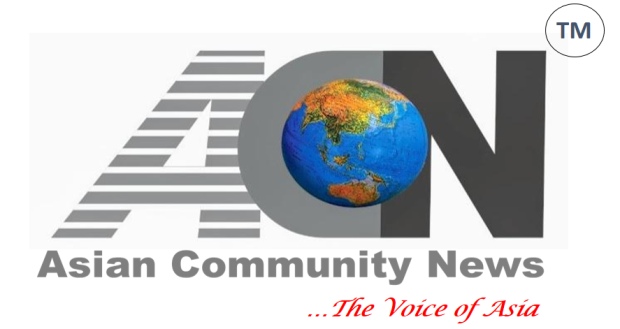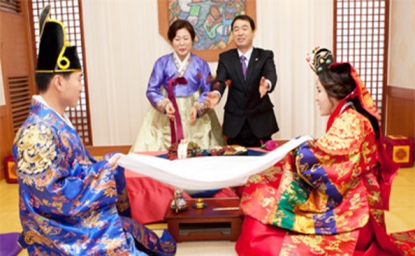Korean Cultural Centre India will present the biggest Korean culture festival ‘Rang De Korea’, on October 15-16 in Delhi to commemorate the 10th anniversary of its establishment in India. One of the most exciting parts will be the traditional Korean wedding ceremony event which will take place at the event. For this event, two couples with a special story will be selected through a preliminary event, and their family and friends will be invited to hold the Korean traditional wedding event on the festival dates. The purpose of the event is to symbolically show the bond between Korea and India as life partner with the essence of Korean traditional culture through a Korean traditional wedding ceremony with pungmulpae (street musical band performance), samulnori (percussion band performance), and haegeum (traditional instrument) performances.
Hwang Il Yong, Director of Korean Cultural Centre India – KCCI writes at length about the traditional Korean wedding ceremony as follows:
Weddings are a joyous occasion, filled with happiness, and hope. Korea and India especially put a lot of meaning and importance on weddings, its customs, ceremonies, traditions, and celebration.
We, Korean Cultural Centre India, present special event for our Indian friends to experience Korean Traditional Wedding Ceremony. We hope to introduce Korea as symbolic life partner, good friend through this event.
Korean traditional weddings are a mirror of Korean culture, reflecting traditional music, dances, and etiquettes. Though modernized over time, Korean traditional wedding customs still survives in Korea.
Here are some of the customs and traditions of a Korean traditional wedding ceremony.
Historically, a traditional Korean wedding is divided into three parts—uihon(의혼), daerye(대례), and hurye (후례).
 Uihon(의혼) refers to the act of matchmaking, wherein the prospect bride and groom’s families discuss the possibility of marriage.
Uihon(의혼) refers to the act of matchmaking, wherein the prospect bride and groom’s families discuss the possibility of marriage.
Uihon has four steps, namely— Hondam (혼담), sending marriage proposal (honseoji 혼서지) and acceptance of marriage; Napchae(납채), sending of Sajudanja(사주단자), a letter containing groom’s date and time of birth; Nahpgil (납길), finalizing the date of wedding by the bride’s side; and Nappae(납폐), sending of wedding
The ham (함) typically contained marriage papers, set of red and blue silk cloth to make the bride’s skirt, and a yellow pouch containing cotton, soybeans, and kidney beans, along with a variety of other gifts such as jewellery, clothes, etc.
Daerye(대례) refers to the main wedding ceremony which traditionally started with Chinyoung (친영), the groom’s wedding procession accompanied by traditional Korean music, going to the bride’s place for the wedding.
Chinyoung (친영) is followed by Jeonanrye(전안례), where the groom presents wooden wild goose to his mother-in-law. This Korean tradition is respected as a symbol of harmony and fidelity.
As most of the marriages in ancient Korea were arranged marriages, Gyobaerye(교배례) ceremony followed Jeonanrye(전안례), where the bride and groom would see each other for the first time and bow to each other representing the promise of commitment to each other.
 After the bowing ceremony, the Bride and Groom share a glass of liquor, historically, two separate halves of a gourd filled with liquor and connected by a thread, as a means of them becoming one by the exchange of the drink in a ceremony called Hapgeunrye (합근례).
After the bowing ceremony, the Bride and Groom share a glass of liquor, historically, two separate halves of a gourd filled with liquor and connected by a thread, as a means of them becoming one by the exchange of the drink in a ceremony called Hapgeunrye (합근례).
Hurye(후례)
Hurye(후례), means ‘post ceremony’. As the name suggests, this ceremony takes place after the main wedding ceremony.
Hurye(후례) historically commenced with the bride parading to the groom’s house in a tiger pelt-covered palanquin in a processional called the woogwi (우귀).
This was followed by Pyebaek (폐백)ceremony, an intimate Korean unification tradition and one of the most important moments of a traditional Korean wedding. Pyebaek (폐백) features Korean historical traditions like formal bowing, a tea ceremony, and the couple catching chestnuts and dates.
The bride and groom do a grand bow, a half bow, and then sit down. Holding a white fabric with flower embroidery, they catch dates and chestnuts that the parents of the bride and groom throw. The number of dates and chestnuts the happy couple catch in the cloth represents the number of children they will have.
Additionally, in a fun ceremony the groom often gives a piggyback ride to his mother and then his bride, symbolizing his acceptance of his obligations to both his mother and wife.
As part of Hurye (후례), three days after the woogwi (우귀) processional, the couple visits the groom’s family shrine to pay respects, in a ceremony called hyeonsadangrye(현사당례).
ATTIRE
For the traditional wedding ceremony, the Bride and Groom wear hanbok, historically made of silk and in colours symbolic of the “taeguk (태국),” or “eum-yang(음양)” (also known as yin and yang) to represent the balance of complementary entities. For a more formal look, the bride wears a wonsam(원삼), an intricate upper garment embroidered with designs in silk thread, along with a full skirt called a chima(치마), while the Groom wears a samogwandae(사모관대), the court attire of the Chosun Dynasty. Alternatively, a less formal yet traditional attire includes the chima(치마)and a jeogori (저고리), a long-sleeved upper garment that is generally shorter compared to the wonsam(원삼) for the bride, and pants called baji(바지) and a jacket called jeogori(저고리) for the groom. With modern times, the wedding hanboks have also modernized and diversified in terms of colour and design.



